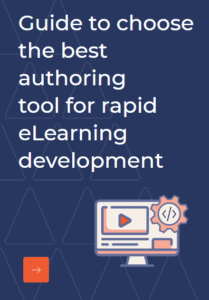Just a few years back a movie titled - 'The Inception'. The plot line of which was as complex as any Christopher Nolan movie and got a mixed review across the globe. While some found the movie interesting due to the intriguing story, some liked it purely due to the visual aspects. What made it successful was the delicate balance between the narrative and visuals. What would have happened if either of those had overpowered the other? The movie would then only be accepted by a selective few.
Something similar works in the case of effective eLearning too. The content-its narrative-and the images or media elements used all play a part in delivering learning effectively. Simply put, there are two parts to eLearning: Instructional Design and Visual Design. But, which one has the upper hand when it comes to the final eLearning course. While it is often arbitrated that, a strong, well devised Instructional design model is the key to creating an extraordinary course, it doesn’t always have to be so.
To understand better we have to dig a bit deeper. To get started, the term Instructional Design is defined by IDC as, "the systematic process by which instructional materials are designed, developed, and delivered." Visual Design on the other hand is defined as, "the use of imagery, color, shapes, typography, and form to enhance usability and improve the user experience. As a field, it has grown out of both UI design and graphic design."
As the definition states, Instructional design is about the content flow, the way of presentation etc. It is a process for content design, that depends on the analysis of performance goals, learners/target audience, training requirements, technological limitations etc. Based on these information, the instructional designer then creates a script or storyboard which dictates how the textual inputs, images, videos, and audio elements will be presented to the audience.
Instructional design determines all the nitty gritty like- usage of game elements, simulation or interactives, the length, the purpose (performance support or general training). This also includes in a broad level the content's visual aspects which otherwise comes under the broader umbrella of visual design (does that make it a subset of Instructional design then?).
Visual design however is handled by s different set of specialists called the graphic designers who actually give life to eLearning. Imagine eLearning for K12 in monotone, boring huh! That's eLearning without visual design. Picking the right color palette and the typeface(that meets accessibility requisites), the layout and navigation, the size, shapes and placement of buttons and other interactive elements etc. comes under visual design. Going overboard with elements, colors etc. can lead to clutter and distraction which weakens the purpose of eLearning, which is why creating a balance is important.
What really works, is a fusion of Instructional design and visual design where each compliments the other. Over the years that we have worked as eLearning providers we have observed that the interactions between instructional designers and graphic designers during the ideation process or after the storyboard creation often helps in bringing out creative solutions. As Jeffrey Zeldman says, "Content precedes design. Design in the absence of content is not design, it's decoration." On the same note in the words of Frank Chimero, "People ignore design that ignores people."
Instructional design may be considered slightly more important, but cannot be completely successful without visual design. So, in conclusion we cannot say that one outdoes the other.
Do you think otherwise? Do share your thoughts.



